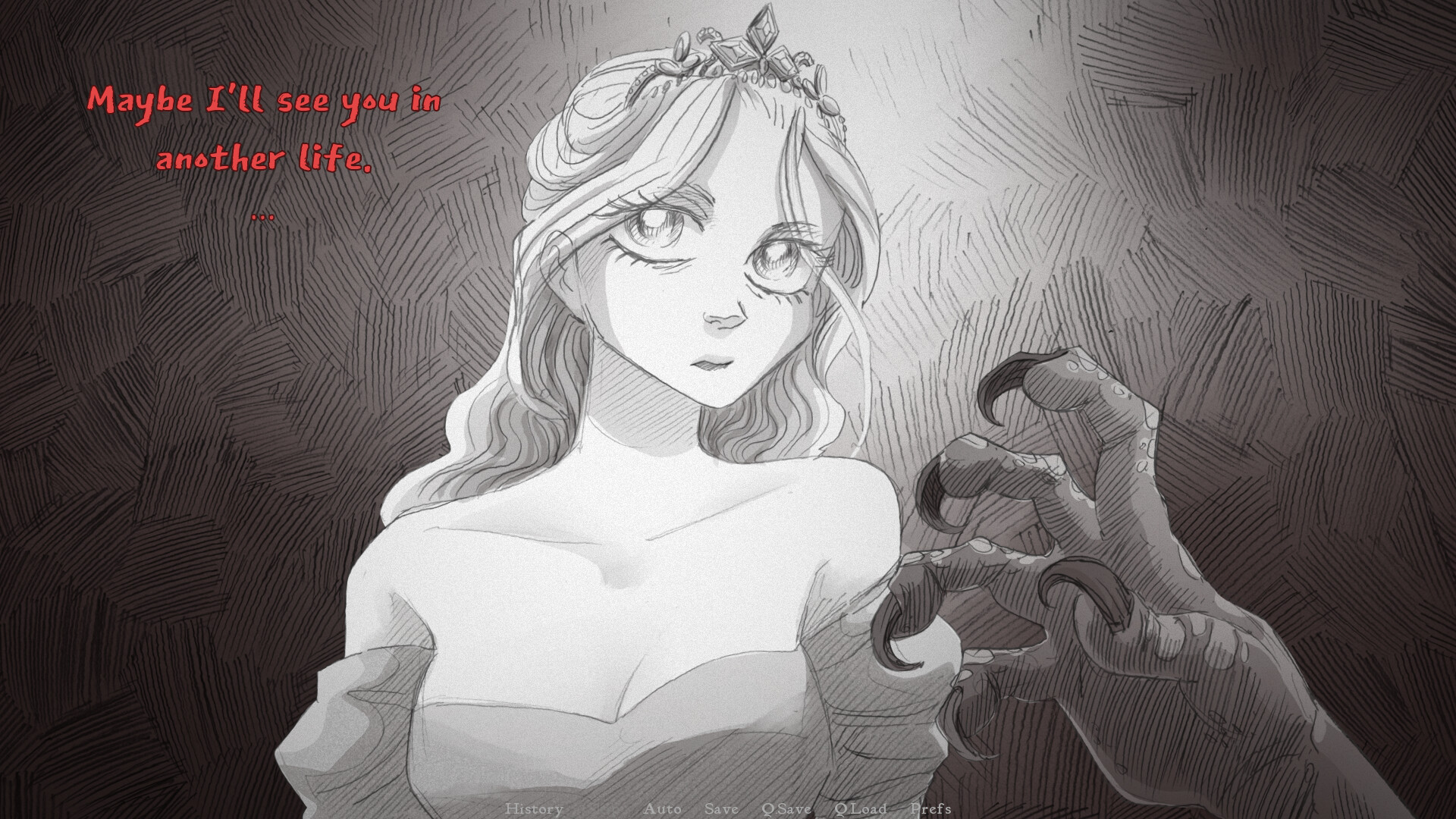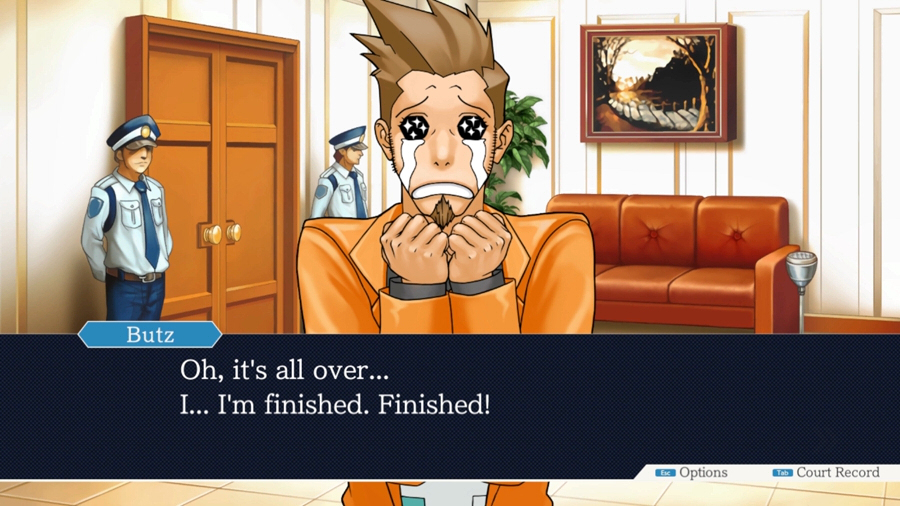Tracy Ha
Read, Write, Play
June 11, 2024
RWP Final Paper: Analysis of Slay the Princess & Ace Attorney
For this paper, I will be comparing Slay the Princess and Ace Attorney – two games that we played this quarter that I quite enjoyed. Both games are visual novels that are both unique in that the dialogue itself is the action of the story. As someone who usually clicks through the dialogue every chance I get, I was expecting these two games to be a bit boring, and was surprised when I found that this was not the case when I was playing Ace Attorney and Slay the Princess. Rather, I was fully engaged in the storyline and its text. I wanted to explore the reason why this is and compare the techniques the two games use to hook the player in. Doing so is reasonable as both are classified as narrative-driven games; if the dialogue is not engaging, what is left in the game? The game’s purpose would then be meaningless, thus it is imperative that the developers do the most they can to make reading the dialogue important to the audience. Overall, Slay the Princess and Ace Attorney both employ interactive elements, emotional effects, character development, all supported by the visuals and audio, in order to craft engaging dialogue.
To begin with, I will provide a brief background of each game. Slay the Princess is a horror visual novel released in 2023. It begins with an unnamed protagonist in the middle of a forest, who is tasked by an offscreen narrator to slay a princess imprisoned in a secluded cabin nearby. The narrator states that the princess is a threat to the world, but does not answer much more than that. As the player, we get a variety of different choices to choose from and they decide one of the many endings that we get. In contrast, Ace Attorney is a much older game; it is a visual novel adventure game that was first released in 2001. In Ace Attorney, the player steps into the shoes of various lawyers to investigate cases and represent clients in court. Since its release, there have been many sequels and even an anime series based on the story. For the first episode, we are playing as Phoenix Wright, a new-time defense attorney tasked with defending his childhood friend, Larry Butz, who was accused of killing his girlfriend. Right off the bat, both games jump into the story with exciting and immediate conflicts.
Firstly, in both games, interactive elements play a vital role in making the dialogue engaging. Slay the Princess does so by laying out multiple interactive dialogue choices for the player to choose from, creating a narrative experience where player decisions directly influence the story’s progression. Each choice leads to different responses and actions from the princess and the narrator, creating a twisting narrative that ensures replayability and an immersive experience. Because of this, the choices are heavy with moral and ethical dilemmas that force players to consider the consequences of their actions, making the dialogue feel personal and impactful. This interactive element ensures that players remain engaged, as their choices are directly controlling the direction and outcome of the story. Not paying attention to the dialogue means missing out on critical cues, potentially leading to an unfavorable ending. Similarly, Ace Attorney’s dialogue allows its players to actively participate in the investigative process. The game’s unique mechanic of presenting evidence during cross-examinations requires its players to carefully listen to dialogue, identify contradictions, and choose the correct pieces of evidence to challenge witness statements. As the attorney, you are actually able to click on the evidence and object in certain areas of the witness statement. This interaction transforms the dialogue from a passive reading experience into a fun, puzzle-solving activity that demands thinking and attention to detail. Additionally, although Ace Attorney is linear compared to Slay the Princess, you are allowed to choose certain lines of questioning and approaches during trials. Like with Slay the Princess, this level of control makes you feel more involved with the storytelling process. In summary, the dialogue is not something to be easily skipped over in Slay the Princess and Ace Attorney, but are an integral part of the gameplay experience.

[chapter 1: setting in the beginning + character choices]
Secondly, both games’ dialogues elicit emotion from the players. Before playing Ace Attorney, I saw many memes and internet jokes about the game, and I completely understand why now. Ace Attorney effectively uses humor and dramatic tension in its dialogue to keep the players emotionally invested in the narrative. Throughout the first episode, moments of intense emotion punctuate the storyline. For example, seeing that Phoenix’s first client was his childhood friend and knowing that he was wrongfully accused, as we saw the real killer in the beginning of the episode, heightened the personal stakes involved. Moreover, being in Phoenix’s head / internal monologue and witnessing his determination to win the case, but also anxiety as a first-time lawyer, added a layer of emotional depth to the story and made the story more relatable. These moments of intense emotion did very well in hooking the audience in and making them invested in not only the story outcomes, but also the characters’ well-being. On the other hand, Slay the Princess does the same, although for darker emotions, employing dialogue to evoke everything from suspense and fear to empathy and confusion. Frankly, when I first played the game, I was downright terrified, and that played a major role in me paying close attention to the story. The narrator and princess’s scripts, as well as the choices laid out for the player, are crafted to manipulate the player’s emotions, making them question their judgment and the morality of their decisions. From the moment the game starts, you are meant to be constantly second-guessing your choices. Kill the princess? But why? She’s going to end the world? What does that mean? You are meant to continue forward with your questions unanswered, and this tension keeps the game compelling and the players on the edge of their seats.
Thirdly, character development is a prominent aspect in both Slay the Princess and Ace Attorney, serving to enrich the narrative and deepen player engagement. In Slay the Princess, the development of the princess is central to the game’s unfolding story. As players make choices, they witness the princess’s personality and motivations evolve, often in unpredictable, even downright scary, ways. Although I have only played the game briefly, I was stunned to see her evolve from a normal looking damsel in distress to a dragon-like creature. I have also witnessed other variations of the princess that are interesting, to say the least, and this unique character growth is what keeps the audience invested as they navigate the consequences of their actions. The player’s decisions, by following certain dialogue, are what is shaping the princess’s behavior and the narrative’s direction, making her a multi-dimensional character whose development feels organic and impactful. The unnamed protagonist that we are playing as is the same – through small glimpses in the mirror, we see that this character is not exactly human, and is not the “hero” voice that we occasionally hear conversing with us and the narrator, which makes you wonder how they grow as the story develops. These mysterious characters further enhance the player’s commitment to the game and its dialogue. Similarly, Ace Attorney excels in character development, particularly through its protagonist, Phoenix Wright, and his interactions with other characters. Phoenix’s growth from a novice lawyer to a confident defense attorney is portrayed through his experiences in and out of the courtroom. The game also delves into the backgrounds and motivations of supporting characters and antagonists, creating a rich network of personalities that contribute to the story’s depth. Each character’s development is memorable and tied to the cases they are involved in, providing a continuous narrative that evolves with each episode. Overall, the characters in both games are not just static entities, but real beings that grow and change alongside the player, adding layers of complexity to the dialogue and overall gaming experience.

[character development: protagonist not human?]
Lastly, both Slay the Princess and Ace Attorney utilize enthralling visuals and audio to enhance their storytelling and create immersive experiences. Slay the Princess employs a black-and-white, pencil-drawn art style that greatly complements the mysterious atmosphere of the storyline. Moreover, the evolving visual design of the princess was also a unique touch that enhanced engagement and served as a visual representation of the consequences of the player’s decisions. The game’s audio design, featuring eerie music and unsettling sound effects, further intensifies the spookiness of the plot, keeping players on edge and deeply engaged with the narrative. Adding to this, the voice acting of each character, especially the princess’s, perfectly complemented the audio and made the story come to life. I think this was a crucial component to ensuring that reading all of the dialogue did not get too dull or tedious. Similarly, in Ace Attorney, the visual and audio elements are equally critical in creating an engaging player experience. The visuals were appealing and detailed, but extreme facial expressions and exaggerated reactions , especially for Larry Butz, were more simple and funny, which were quite entertaining. The comedic relief I mentioned earlier were portrayed efficiently through this dialogue and imagery. For instance, the bright red bubbles with OBJECTION and TAKE THAT, along with the corresponding sounds, were amusing, as well as the blue narration depicting Phoenix’s thoughts (hands shaking…..). These visual effects carry over to the distinct character designs, which add a layer of excitement to the gameplay. It was easy to get fully involved in winning the case when the murderer was perfectly depicted as a sleazebag. To sum up, the combination of expressive visuals and a dynamic audio score ensures that players are fully immersed in the dialogue and overall storyline.

[red speech bubbles when we objected]

[Larry Butz’s funny expressions]
In conclusion, both Slay the Princess and Ace Attorney employ a variety of techniques to make their dialogue engaging and integral to the overall gaming experience. From interactive elements and emotional impact to character development and visual/audio cues, these games rely on dialogue as a powerful tool to immerse players in each game’s respective narratives. The branching dialogue paths in Slay the Princess and the investigative gameplay in Ace Attorney ensure that players’ choices directly impact the story, making each playthrough unique. Both games also find a way to play with your heart strings and get you emotionally involved in the game. Additionally, the character development in both games adds depth to the storytelling, making the characters feel like real entities rather than mere game pieces that the players are detached from. Wrapping it all up, the detailed visuals and alluring audio effects reinforce these elements, making the game feel more interactive and emotionally impactful.
Overall, the dialogue in these games is not just a means of conveying information but a core gameplay element that shapes the player’s experience and investment in the story. The combination of these techniques creates rich, interactive worlds that captivate players and highlight the importance of dialogue in narrative-driven games. These two games have hooked me into the world of visual novel games, and I look forward to playing more of this genre and analyzing how their techniques overlap or differ.



